It was a perfect day for riding in Malibu Creek State Park, and 28 smart riders came out for the free Basic Skills Clinic, which is always held the first Saturday of the month. This was by far the largest group we’ve had in over a year! The park was also full of hikers, and we even saw a couple of equestrians. You can see the photos in our April photo gallery.
April 2015 Skills Clinic Photos Posted April 4th
April 4th, 2015What’s Next for the San Gabriels?
March 27th, 2015On Wednesday, March 25th, the Sierra Club did a panel presentation on the future of the San Gabriel Mountains. The panel members were Steve Scauzillo, local newspaper reporter, Daniel Lovato, Acting Supervisor, Angeles National Forest, Belinda Faustinos, Vice Chair, San Gabriel Mountains Forever, Tim Brick, Managing Director, The Arroyo Seco Foundation, and Edward Belden, Southern California Program Associate, National Forest Foundation.
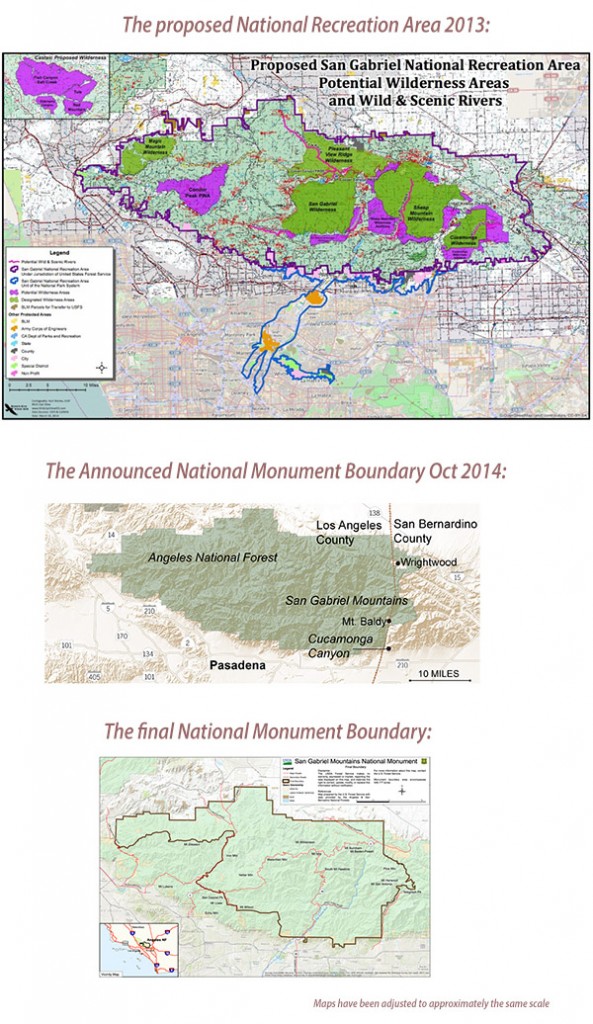 More money is coming for projects. Tentative plans include funding for ongoing and new restoration and redevelopment programs, removal of invasive species, funding of youth employment programs, hiring of paid personnel for the Visitors Centers and the development of a “Field Ranger” program. They will be filling the visitor center positions by hiring recently returned veterans as part of a post-military service job placement program. Some of those will be on the ground by Memorial Day.
More money is coming for projects. Tentative plans include funding for ongoing and new restoration and redevelopment programs, removal of invasive species, funding of youth employment programs, hiring of paid personnel for the Visitors Centers and the development of a “Field Ranger” program. They will be filling the visitor center positions by hiring recently returned veterans as part of a post-military service job placement program. Some of those will be on the ground by Memorial Day.Are you ready for a Bike Park?
March 26th, 2015We are. We think Los Angeles is too.
CORBA has been working to bring bike parks to Southern California for some time. Since CORBA volunteers built their first pump track (on a private property) in 2007, we’ve been watching the community bike park movement grow and accelerate around us.
We’ve had some success. Fillmore Bike Park is now officially open and available to ride. Thousand Oaks included bike park facilities in their recently approved plans for Sapwi Trails Community Park. Kernville has a bike park and BMX track. These are the result of dedicated mountain bikers showing up to meetings and asking for them, then following through to make it happen.
Our neighboring IMBA Chapters in Orange, San Diego and Riverside Counties are all working on bringing bike parks to their communities. Now we’re ready to ask Los Angeles.
In January, the Los Angeles Dirt Park Collective was formed. CORBA has joined the Collective in their mission to bring pump tracks, dirt jumps, and bike parks to Los Angeles. We know there’s demand, but at this stage we need to let the decision makers know just how great that demand is.
How can you get involved? Right now we need a show of support. Follow the L.A. Dirt Park Collective on Facebook at http://www.facebook.com/LADirtPark
Sign the petition, share it with your friends, and help spread the word. https://www.change.org/p/spread-the-word-and-help-us-create-the-first-ever-los-angeles-dirt-park
Another successful COSCA Trail Work Day held March 21st
March 23rd, 2015Over 100 volunteers, including 16 from CORBA, gathered in the Hill Canyon region of Wildwood Park in Thousand Oaks to help with the 2015 COSCA Spring Trail Work Day. The volunteers broke into six crews and worked on three different trails.
Crews 1 and 2 worked on the Gas Line Road, a dirt road that leads from Hill Canyon to the Canyon Overlook Trail that was build during the 2012 Spring COSCA Trail Work Day. Most people cleared loose rocks from the road and filled in some ruts, while a few built a short access singletrack from the parking area at the bottom.
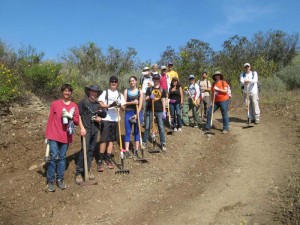
CORBA volunteers pose in front of the ditch to keep rain water off the chicane near the bottom of the Lizard Rock Trail.
Three crews worked the bottom of Lizard Rock Trail, leveling the tread where ruts had started to form, clearing overgrowing brush, building a reroute of a few hundred feet, and building a long ditch to keep water off a chicane. The latter is where the CORBA crew worked, and spent most of their effort.
Among the CORBA volunteers were five members of the Calabasas high school mountain biking club and two parents. There was another contingent from Newbury Park High School working with one of the other crews.
The final crew worked on the Eagle Point Trail, clearing dirt from the many steps and doing brush removal.
The Santa Monica Trails Council trail crew did much of the preparatory work, and fielded crew leaders for all crews except for CORBA’s.
All the volunteers gathered back at the parking area about noon for the barbecue provided by the COSCA rangers. The turn out was unexpectedly large, about double previous years; even so there were plenty of burgers (beef and veggie), hot dogs, chips and sodas for everybody.
Thanks to the CORBA volunteers and others for helping to keep the local trails in great condition!
You can see more photos of the event in our photo gallery.
Topanga State Park Fire Road Maintenance
March 19th, 2015California State Parks will be performing maintenance on all fire roads throughout the park. The project is underway and will take several weeks. This is considered routine maintenance, to restore the fire roads to their intended purpose, as well as to prevent further degradation of the roads and impacts to the environment.
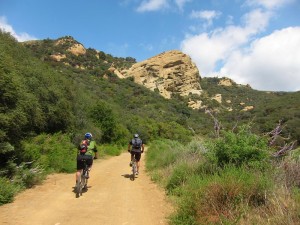
Eagle Springs Loop now undergoing road maintenance
Every time maintenance of this type is done, we know that there are many experienced mountain bikers who don’t like the changes. Having our favorite “challenging sections” smoothed over often comes as a surprise. On the other hand, some riders welcome the improvements. But regardless, the fire roads will change.
Why is this being done? Fire roads are primarily transportation corridors for fire fighting, emergency vehicle access, administrative work within the parks, and for recreation. Over time, all dirt fire roads degrade and begin to develop ruts and water channels form. Once the ruts begin to form, rain will then extend and deepen those ruts. This creates additional challenge for cyclists, but it also makes it more difficult for the State Parks administration to do their job of managing the park. Their primary mission is to preserve the park and it’s natural resources for us and our future generations.
Currently fire road maintenance work is being done on the Eagle Springs loop to repair existing damage, reduce future maintenance needs, and to provide additional protection of the environment. The Regional Water Quality Control Board mandates State Parks and other land managers to reduce sediments washed into the creeks and streams. Studies have demonstrated that fire roads are major contributors to this problem. State Parks had to determine which fire roads were causing the most erosion and sediment runoff in both Malibu Creek State Park and Topanga State Park. They have identified Eagle Springs loop as a priority project.
State Parks are currently outsloping as many areas of the roads as possible. We always try to outslope trails when we do trail maintenance. Outsloping helps shed water off the trail or road. Insloped roads carry and channel water and the more water carried causes more erosion. In some particularly bad areas in Topanga State Park, roads have lost about five feet of material across the whole eighteen feet of width of the road.
The sediment washed off these roads heavily impacts streams and creeks in the parks as it makes its way to Santa Monica Bay. On a state-wide basis State Parks has turned to outsloping all back country roads and trails. This has shown to reduce erosion and be a more sustainable maintenance practice. In the long run sediment runoff will be greatly reduced, further protecting the streams, creeks and the environment as a whole.
Eagle Rock Fire Road was given the highest priority in Topanga since it showed the heaviest erosion. It was no longer accessible by vehicles. It was also causing damage and erosion on Musch Trail, which joins the road.
State Parks appreciates your understanding, and CORBA, supports their efforts to reduce impacts to the environment. We all want to protect the places we play and ride. If that means grading over a section of road to make it more sustainable, we’re fine with that. The alternative is to decommission the road and close it to all users, something none of want to see.
During and for some time after construction, the roads will not be very pretty, and may be soft and loose until the tread gets packed down. In time, they’ll return to a more natural looking state. Most mountain bike injuries occur on fire roads, due to the ease with which we can gain speed. So as we ride these newly graded roads, remember to be safe, and that there is a 15mph speed limit on all trails and fire roads within the Santa Monica Mountains National Recreation Area.
Alex Baum: A Tribute
March 10th, 2015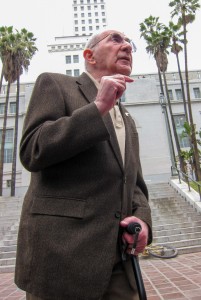
Alex Baum, bigger than City Hall
On March 1st 2015, Los Angeles and the world lost a giant in the world of bicycle advocacy when Alex Baum passed away at 92 years old. A modest man of great integrity, he may have accomplished more in his over 40+ years of bicycle advocacy than all the advocacy groups combined. He never met a bicycle project, program or cause that he didn’t get behind in some way…and his impact was felt worldwide.
Alex was a holocaust survivor. Born in France he grew up in the years right before WWII. He and his brother Marcel were involved with the French Resistance and assisted by guiding allied troops and others back to safety. Eventually captured by the Germans, Alex and his brother were imprisoned in several concentration camps including a Nazi labor camp where he was helping build the V2 rockets and secretly sabotaging them at the same time.
After the war, Alex played on the French National Soccer team before he, his brother and their families immigrated to the United States. Eventually settling in California, Alex built a successful catering business. Alex’s love of cycling was cultivated once again. Originally, Alex and his family played host when stages of the Tour de France came through their home town of Vic‐Sur‐Seille, near Lyon.

SIgning of the LA Bike Plan
Alex’s impact can be seen everywhere in Los Angeles County. Early on in his involvement he served on the board of the Encino Velodrome and the United States Cycling Federation (later USA Cycling), and was the first American appointed to the Union Cycliste International. Alex was appointed to the organizing committee for the 1984 Los Angeles Games. He was involved in 7‐11 becoming a sponsor of pro‐cycling in the United States and sponsoring the Olympic Velodrome in Los Agneles. Ahead of his time, Alex helped get women’s cycling introduced into the Olympic Games in Los Angeles. Alex was also instrumental in putting together the Tour de California.
Alex chaired and served on the Mayor’s Bicycle Advisory Committee for over 30 years. He envisioned the LA River Bike Path and many more bike lanes and routes throughout the region. In 2012 on his 90th birthday they rededicated the bridge over Los Feliz as the Alex Baum Bicycle Bridge. Alex was responsible for the LAPD building up a bicycle patrol program and was involved in the funding and acquisition of their first police bikes.
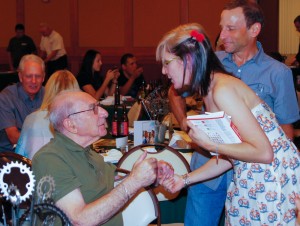
Alex and Jennifer Klausner at CORBA’s 25th Anniversary
He was a close confidant of Mayor Tom Bradley and many other political, business and important figures…from the police chief to the mayor to county supervisors and studio heads. Everyone loved and respected Alex. Walking through city hall with Alex was like being with a true celebrity. Alex had access (no appointment necessary) to every city council office in city hall.
Alex never rode a mountain bike…but that didn’t stop him from trying to get trails opened in the city of Los Angeles. What was unique about Alex was his willingness to help and to share his contacts for any bicycle project. He would gladly take you “under his wing” through city hall to help expedite or initiate the necessary contacts to get a project through. He adopted CORBA as one of his pet projects and did everything he could to help us with LA City mountain bike access. CORBA awarded Alex the Al Farrell award in 1999, but we could have given it to him many times over for all of his efforts.
There are many stories…Alex he loved to share his stories. Alex’s family hosted Jesse Owens after the 1936 Berlin Olympics when athletes did not get “sponsored” for their travel to and from the games…and athletes of color couldn’t easily get accommodations anywhere. Years later Alex bumped in to Jesse at LAX surrounded by a group of fans and well‐wishers. Alex made his way up and re‐introduced himself to Jesse…and Jesse gave Alex a big hug and broke down in tears remembering what his family had done for him. This was Alex…he was a legend to the legends.
Another great Alex story happened right after the 1994 Northridge earthquake. Living in North Hollywood, he went to a local 7‐11 and found the store owner selling water for $20/ gallon as it was in short supply. Alex said something about the ethics of price gouging to the owner, but was told it was none of his business and that he (the owner) could charge whatever he wanted.
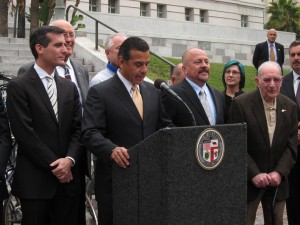
Councilman Garcetti (now Mayor), Mayor Villaragosa, Councilman Ed Reyes, LACBC’s Jennifer Klausner and Alex Baum
Alex did not argue with the owner…he left and went home to call an executive at 7‐11 (remember, he had relationships at the highest level at 7‐11 from his involvement with their sponsorship of cycling). Within a short time, the store owner was back to selling water at the regular price…under threat from 7‐11 management of losing his franchise. Alex was very effective when he set his mind to something.
Above all Alex loved his family and the people he met through cycling…and we loved him. Alex will be missed by many, but his impact will live on and positively affect millions for many years to come.
March 2015 Skills Clinic Photos Posted March 9th
March 9th, 2015On a beautiful day for riding in Malibu Creek State Park, there was a surprisingly small group of only 11 at the free Basic Skills Clinic, which is always held the first Saturday of the month. You can see the photos in our March photo gallery.
March eTerraTimes Newsletter Published March 5
March 5th, 2015The March edition of CORBA’s monthly newsletter, the eTerraTimes, was published today, March 5th. If you don’t get it by email, you can view it online.
As always, the eTerraTimes has all the latest news for mountain bikers in the Santa Monica Mountains and surrounding areas. This month’s issue includes an Action Alert to help save the Epic Palm Canyon Ride route, near Palm Springs.
President’s Message: Collaboration is Key
March 4th, 2015In this day and age the most effective way to achieve anything for the public good is to collaborate. Whether those collaborations are with land managers, other trail user groups, public-private partnerships, or other entities, they are necessary. Nothing gets accomplished in a vacuum.
It was through a collaboration with a number of different groups that the Strawberry Peak loop was restored and re-opened in the Angeles National Forest, now the San Gabriel Mountains National Monument. It was only possible with several groups pooling and sharing resources and coordinating our efforts. We couldn’t have done it alone.
To help bolster support and improve community participation in and stewardship of the new San Gabriel Mountains National Monument, a Community Collaborative group has been formed. As one of the 12 “steering committee” members, I had the opportunity to help shape what that group will look like. The first meeting of the full Collaborative group was on March 4th, 2015.
At that meeting we had a broad range of interests in attendance. About five people from the invitee list were absent, which is to be expected trying organize a group of this size. The first order of the day was introductions. Water was well-represented with several water districts and the association of water districts in attendance. We had Caltrans, Edison, two LA County representatives including a District 5 representative, and Flood control. There was also a San Bernardino County representative. Also present were a number of councils of governments, and a council of chambers of commerce. Recreation was represented BY CORBA, California Off-Road Vehicle Association and the Community Hiking Club, and Mount Baldy resort. Native American interests were there, along with several social and health justice organizations. The National Forest Foundation did an excellent job of winnowing down an extensive interest list to bring this group together.
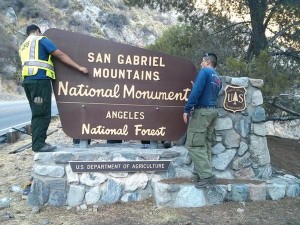 Since this was the first meeting of the full collaborative group, most of the day was spent going over and refining the draft documents that the steering committee had prepared. This included the guiding documents for the Collaborative, the Statement of Purpose, the Goals and the Code of Conduct. There was a lot of similar discussions to those the steering committee had already had, but these new points of view raised some issues that weren’t well-covered in our draft. We refined the documents and by day’s end, the group had formally ratified and adopted them.
Since this was the first meeting of the full collaborative group, most of the day was spent going over and refining the draft documents that the steering committee had prepared. This included the guiding documents for the Collaborative, the Statement of Purpose, the Goals and the Code of Conduct. There was a lot of similar discussions to those the steering committee had already had, but these new points of view raised some issues that weren’t well-covered in our draft. We refined the documents and by day’s end, the group had formally ratified and adopted them.
We also heard an approximate timeline on the development of the Management Plan for the new monument, which must be completed by October 10, 2017, as stated in the Presidential Proclamation. Currently the Forest Service is developing a plan on how to reach out to the community effectively, this group being a key component of that plan. They have started preparing a “Need for Change” document, which states what needs to be changed in the current Angeles National Forest Management Plan to bring it into alignment with the language of the Proclamation. This need for change document will be posted publicly in the coming months as the starting point for the public process of developing the new management plan.
The group agreed to meet monthly during this first and extremely important year of the management plan development. We will continue to be active throughout the three-year process, and beyond.
Collaboration is key to the success of this endeavor. One of the big changes in the 2012 Forest Planning Rule, was an added emphasis on collaborative efforts as a more productive way of engaging the public in planning processes. There are many collaborative groups working on different Forests and Monuments, but this is the first in a major metropolitan area. Our population base and size presents unique challenges, but I’m confident that this Collaborative will be a productive one, supporting the efforts of the Forest Service to improve the Forest, this new National Monument, and to benefit the communities that depend on it.
One of my roles as a member of the Community Collaborative is to bring your concerns to the table going forward. Feel free to contact me with any concerns that you might find. In turn, I’ll be reporting back to you on the work and progress of the Collaborative, in addition to the Forest Service management plan development process.
Thanks to the National Forest Foundation for serving as neutral facilitators and organizers of this group. The purpose statement and code of conduct adopted on March 5, 2015 are below:
2015 – Statement of Purpose and Goals
2015 – Community Collaborative Code of Conduct
Action Alert: Save the Palm Canyon Epic
March 4th, 2015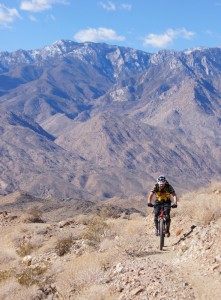
Epic views of the Santa Rosa Mountains
Palm Canyon Epic (PCE) is one of the iconic long-distance rides of Southern California. It’s a spectacular point-to-point route in the Santa Rosa Mountains, south of Palm Springs and Cathedral City. It’s a place that many dedicated mountain bikers make an annual winter pilgrimage to ride.
Though it’s outside CORBA’s territory, many CORBA members and supporters ride the trail. The BLM has completed an environmental document for a land swap with the Agua Caliente band of Cahuila Indians. When the land was parceled out in the 1800’s, it was done in a checkerboard fashion. Alternating lots were deeded to the Indian tribe and to the U.S. government through the BLM. The land swap is an attempt to consolidate ownership of contiguous properties so the land can be more easily managed.
While the tribe’s stewardship of their lands has been positive, the tribe doesn’t allow bicycles on trails. They charge a fee for hikers and equestrians. In the land swap, portions of the Palm Canyon trail, and many other trails important to the local communities, would become tribal land. Though the tribe have stated they would keep the trail open, there is nothing in this environmental document requiring them to do so. They’ve already posted “no bikes” signs on the Indian Potrero trail, which crosses tribal land for a short distance, and is a part of the classic PCE.
Now is the time to make your voice heard and write to the BLM. We believe it is in everyone’s best interest to keep these trails within public ownership (BLM). Scenario 1 is our preferred option, which keeps the trails with the BLM. Our colleagues at the San Diego Mountain Bike Association provide more background information and have drafted a letter that you can cut and paste. You can find their letter here. Comments must be received by March 29th, 2015!
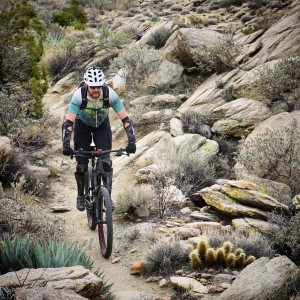
Beautiful and challenging
Whether you’ve already ridden it and love it, or would like to be able to do so in the future, do it now! It will only take a minute or two of your time, and every letter or email sent counts.
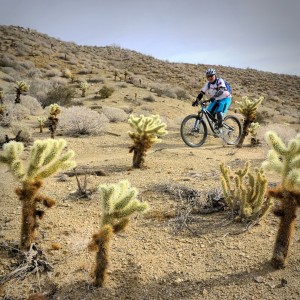
A classic long-distance desert ride
If you’re not familiar with this epic rides, you can watch a couple of Palm Canyon mountain biking videos.



